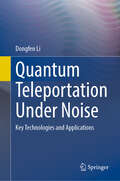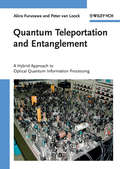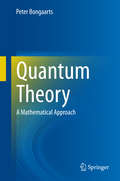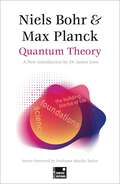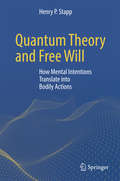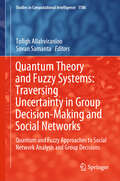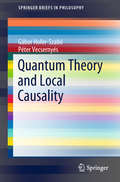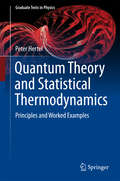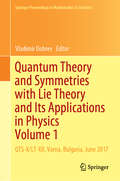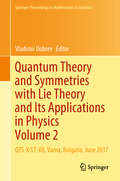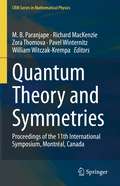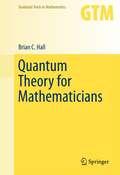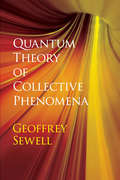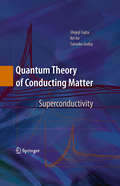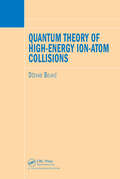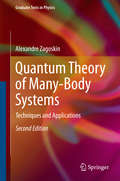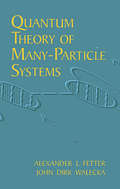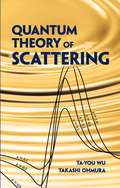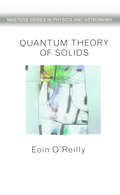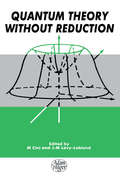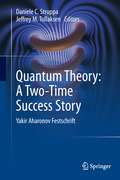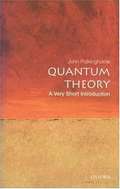- Table View
- List View
Quantum Teleportation Under Noise: Key Technologies and Applications
by Dongfen LiThis book offers a deep dive into quantum teleportation and immune noise models, providing cutting-edge solutions to challenges in noisy quantum communication systems. It covers advanced theories and practical methods for building robust, high-fidelity quantum channels that ensure secure communication even in noisy environments, making it a vital resource for researchers and professionals in quantum information science. Key topics include quantum teleportation protocols, immune noise models, quantum information splitting, and multi-degree-of-freedom quantum teleportation. By developing a unified framework for high-fidelity quantum channels, the book tackles major issues like "entanglement death," decoherence, and channel capacity limitations. It offers solutions to improve quantum state fidelity, channel performance, and security, enhancing the practicality of quantum teleportation in areas like national defense, finance, and secure communication. The book targets academic researchers, engineers, and professionals in quantum information, cryptography, and secure communications, along with advanced students interested in quantum teleportation in noisy environments.
Quantum Teleportation and Entanglement: A Hybrid Approach to Optical Quantum Information Processing
by Akira Furusawa Peter van LoockUnique in that it is jointly written by an experimentalist and a theorist, this monograph presents universal quantum computation based on quantum teleportation as an elementary subroutine and multi-party entanglement as a universal resource. Optical approaches to measurement-based quantum computation are also described, including schemes for quantum error correction, with most of the experiments carried out by the authors themselves. Ranging from the theoretical background to the details of the experimental realization, the book describes results and advances in the field, backed by numerous illustrations of the authors' experimental setups. Aimed at researchers, physicists, and graduate and PhD students in physics, theoretical quantum optics, quantum mechanics, and quantum information.
Quantum Theory
by Peter BongaartsThis book was inspired by the general observation that the great theories of modern physics are based on simple and transparent underlying mathematical structures - a fact not usually emphasized in standard physics textbooks - which makes it easy for mathematicians to understand their basic features. It is a textbook on quantum theory intended for advanced undergraduate or graduate students: mathematics students interested in modern physics, and physics students who are interested in the mathematical background of physics and are dissatisfied with the level of rigor in standard physics courses. More generally, it offers a valuable resource for all mathematicians interested in modern physics, and all physicists looking for a higher degree of mathematical precision with regard to the basic concepts in their field.
Quantum Theory (Foundations)
by Max Planck Niels BohrBohr and Planck helped shaped the cultural landscape of the world today. Now their work is available here in a digestible, pocket format for the modern reader.A concise, uncluttered edition for the modern reader, with a new introduction. Quantum Theory contains two foundational works of quantum research from the early years of the 20th Century, representing breakthroughs in science that radically altered the landscape of modern knowledge: Quantum Theory of Line-Spectra by Niels Bohr and The Origin and Development of the Quantum Theory by Max Planck.The FLAME TREE Foundations series features core publications which together have shaped the cultural landscape of the modern world, with cutting-edge research distilled into pocket guides designed to be both accessible and informative.
Quantum Theory and Free Will
by Henry P. StappThis book explains, in simple but accurate terms, how orthodox quantum mechanics works. The author, a distinguished theoretical physicist, shows how this theory, realistically interpreted, assigns an important role to our conscious free choices. Stapp claims that mainstream biology and neuroscience, despite nearly a century of quantum physics, still stick essentially to failed classical precepts in which mental intentions have no effect upon our bodily actions. He shows how quantum mechanics provides a rational basis for a better understanding of this connection, even allowing an explanation of certain phenomena currently held to be "paranormal". These ideas have major implications for our understanding of ourselves and our mental processes, and thus also for the meaningfulness of our lives.
Quantum Theory and Fuzzy Systems: Quantum and Fuzzy Approaches to Social Network Analysis and Group Decisions (Studies in Computational Intelligence #1186)
by Tofigh Allahviranloo Sovan SamantaThis book dives into the fascinating intersection of quantum theory and fuzzy systems. This work is inspired by quantum theory and its real-world applications. It bridges the gap between abstract theoretical concepts and practical implementations in quantum theory-based group decision-making and graph theory/social networks. Highlights: Core concepts: Begin with uncertainty in quantum theory and fuzzy systems and familiarise yourself with the basics of quantum graphs. Real-World Applications: Explore methods for multi-attribute group decision-making, choosing green building materials, and evaluating wearable health devices, renewable energy options, and cell phones using quantum decision methods. Advanced Exploration: Investigate dynamic centrality measures for brain networks, routing protocols, centrality metrics, link prediction, and applications of quantum graphs. Comprehensive topics: Learn about green supplier selection, investment decisions under uncertainty, sustainable solar energy management, and more. Innovative approaches: Examine topological indices, dominance theory, applications of quantum computing, social fuzzy and quantum networks, scenarios of co-concurrence, and optimization techniques in quantum graphs. This comprehensive guide is an indispensable resource for students, researchers, and professionals who want to explore the applications of quantum theory in network science, quantum computing, and decision-making. Whether readers are experts or novices, this book provides knowledge and practical insights to navigate the complexity of uncertainty in our networked world.
Quantum Theory and Local Causality (SpringerBriefs in Philosophy)
by Gábor Hofer-Szabó Péter VecsernyésThis book summarizes the results of research the authors have pursued in the past years on the problem of implementing Bell's notion of local causality in local physical theories and relating it to other important concepts and principles in the foundations of physics such as the Common Cause Principle, Bell's inequalities, the EPR (Einstein-Podolsky-Rosen) scenario, and various other locality and causality concepts. The book is intended for philosophers of science with an interest in the formal background of sciences, philosophers of physics and physicists working in foundation of physics.
Quantum Theory and Statistical Thermodynamics
by Peter HertelThis textbook presents a concise yet detailed introduction to quantum physics. Concise, because it condenses the essentials to a few principles. Detailed, because these few principles - necessarily rather abstract - are illustrated by several telling examples. A fairly complete overview of the conventional quantum mechanics curriculum is the primary focus, but the huge field of statistical thermodynamics is covered as well. The text explains why a few key discoveries shattered the prevailing broadly accepted classical view of physics. First, matter appears to consist of particles which, when propagating, resemble waves. Consequently, some observable properties cannot be measured simultaneously with arbitrary precision. Second, events with single particles are not determined, but are more or less probable. The essence of this is that the observable properties of a physical system are to be represented by non-commuting mathematical objects instead of real numbers. Chapters on exceptionally simple, but highly instructive examples illustrate this abstract formulation of quantum physics. The simplest atoms, ions, and molecules are explained, describing their interaction with electromagnetic radiation as well as the scattering of particles. A short introduction to many particle physics with an outlook on quantum fields follows. There is a chapter on maximally mixed states of very large systems, that is statistical thermodynamics. The following chapter on the linear response to perturbations provides a link to the material equations of continuum physics. Mathematical details which would hinder the flow of the main text have been deferred to an appendix. The book addresses university students of physics and related fields. It will attract graduate students and professionals in particular who wish to systematize or refresh their knowledge of quantum physics when studying specialized texts on solid state and materials physics, advanced optics, and other modern fields.
Quantum Theory and Symmetries with Lie Theory and Its Applications in Physics Volume 1: QTS-X/LT-XII, Varna, Bulgaria, June 2017 (Springer Proceedings in Mathematics & Statistics #263)
by Vladimir DobrevThis book is the first volume of proceedings from the joint conference X International Symposium “Quantum Theory and Symmetries” (QTS-X) and XII International Workshop “Lie Theory and Its Applications in Physics” (LT-XII), held on 19–25 June 2017 in Varna, Bulgaria. The QTS series was founded on the core principle that symmetries underlie all descriptions of quantum systems. It has since evolved into a symposium at the forefront of theoretical and mathematical physics. The LT series covers the whole field of Lie theory in its widest sense, together with its applications in many areas of physics. As an interface between mathematics and physics, the workshop serves as a meeting place for mathematicians and theoretical and mathematical physicists. In dividing the material between the two volumes, the Editor has sought to select papers that are more oriented toward mathematics for the first volume, and those focusing more on physics for the second. However, this division is relative, since many papers are equally suitable for either volume. The topics addressed in this volume represent the latest trends in the fields covered by the joint conferences: representation theory, integrability, entanglement, quantum groups, number theory, conformal geometry, quantum affine superalgebras, noncommutative geometry. Further, they present various mathematical results: on minuscule modules, symmetry breaking operators, Kashiwara crystals, meta-conformal invariance, the superintegrable Zernike system.
Quantum Theory and Symmetries with Lie Theory and Its Applications in Physics Volume 2: QTS-X/LT-XII, Varna, Bulgaria, June 2017 (Springer Proceedings in Mathematics & Statistics #255)
by Vladimir DobrevThis book is the second volume of the proceedings of the joint conference X. International Symposium “Quantum Theory and Symmetries” (QTS-X) and XII. International Workshop “Lie Theory and Its Applications in Physics” (LT-XII), 19–25 June 2017, Varna, Bulgaria.The QTS series started around the core concept that symmetries underlie all descriptions of quantum systems. It has since evolved into a symposium on the frontiers of theoretical and mathematical physics. The LT series covers the whole field of Lie Theory in its widest sense together with its applications in many facets of physics. As an interface between mathematics and physics the workshop serves as a meeting place for mathematicians and theoretical and mathematical physicists.In the division of the material between the two volumes, the Editor has tried to select for the first and second volumes papers that are more oriented toward mathematics and physics, respectively. However, this division is relative since many papers could have been placed in either volume. The topics covered in this volume represent the most modern trends in the fields of the joint conferences: symmetries in string theories, conformal field theory, holography, gravity theories and cosmology, gauge theories, foundations of quantum theory, nonrelativistic and classical theories.
Quantum Theory and Symmetries: Proceedings of the 11th International Symposium, Montreal, Canada (CRM Series in Mathematical Physics)
by Pavel Winternitz M. B. Paranjape Richard MacKenzie Zora Thomova William Witczak-KrempaThis volume of the CRM Conference Series is based on a carefully refereed selection of contributions presented at the "11th International Symposium on Quantum Theory and Symmetries", held in Montréal, Canada from July 1-5, 2019. The main objective of the meeting was to share and make accessible new research and recent results in several branches of Theoretical and Mathematical Physics, including Algebraic Methods, Condensed Matter Physics, Cosmology and Gravitation, Integrability, Non-perturbative Quantum Field Theory, Particle Physics, Quantum Computing and Quantum Information Theory, and String/ADS-CFT. There was also a special session in honour of Decio Levi. The volume is divided into sections corresponding to the sessions held during the symposium, allowing the reader to appreciate both the homogeneity and the diversity of mathematical tools that have been applied in these subject areas. Several of the plenary speakers, who are internationally recognized experts in their fields, have contributed reviews of the main topics to complement the original contributions.
Quantum Theory at the Crossroads
by Guido Bacciagaluppi Antony ValentiniThe 1927 Solvay conference was perhaps the most important in the history of quantum theory. Contrary to popular belief, questions of interpretation were not settled at this conference. Instead, a range of sharply conflicting views were extensively discussed, including de Broglie's pilot-wave theory (which de Broglie presented for a many-body system), Born and Heisenberg's 'quantum mechanics' (which apparently lacked wave function collapse or fundamental time evolution), and Schrödinger's wave mechanics. Today, there is no longer a dominant interpretation of quantum theory, so it is important to re-evaluate the historical sources and keep the debate open. This book contains a complete translation of the original proceedings, with essays on the three main interpretations presented, and a detailed analysis of the lectures and discussions in the light of current research. This book will be of interest to graduate students and researchers in physics and in the history and philosophy of quantum theory.
Quantum Theory for Mathematicians
by Brian C. HallAlthough ideas from quantum physics play an important role in many parts of modern mathematics, there are few books about quantum mechanics aimed at mathematicians. This book introduces the main ideas of quantum mechanics in language familiar to mathematicians. Readers with little prior exposure to physics will enjoy the book's conversational tone as they delve into such topics as the Hilbert space approach to quantum theory; the Schrödinger equation in one space dimension; the Spectral Theorem for bounded and unbounded self-adjoint operators; the Stone-von Neumann Theorem; the Wentzel-Kramers-Brillouin approximation; the role of Lie groups and Lie algebras in quantum mechanics; and the path-integral approach to quantum mechanics. The numerous exercises at the end of each chapter make the book suitable for both graduate courses and independent study. Most of the text is accessible to graduate students in mathematics who have had a first course in real analysis, covering the basics of L2 spaces and Hilbert spaces. The final chapters introduce readers who are familiar with the theory of manifolds to more advanced topics, including geometric quantization.
Quantum Theory from First Principles: An Informational Approach
by Giulio Chiribella Giacomo Mauro D’ariano Paolo PerinottiQuantum theory is the soul of theoretical physics. It is not just a theory of specific physical systems, but rather a new framework with universal applicability. This book shows how we can reconstruct the theory from six information-theoretical principles, by rebuilding the quantum rules from the bottom up. Step by step, the reader will learn how to master the counterintuitive aspects of the quantum world, and how to efficiently reconstruct quantum information protocols from first principles. Using intuitive graphical notation to represent equations, and with shorter and more efficient derivations, the theory can be understood and assimilated with exceptional ease. Offering a radically new perspective on the field, the book contains an efficient course of quantum theory and quantum information for undergraduates. The book is aimed at researchers, professionals, and students in physics, computer science and philosophy, as well as the curious outsider seeking a deeper understanding of the theory.
Quantum Theory of Collective Phenomena (Dover Books on Chemistry)
by Prof. G. L. SewellThis systematic approach to the quantum theory of collective phenomena is based principally on the model of infinite systems. Suitable for advanced undergraduates and graduate students of physics and chemistry, the three-part treatment begins with an exposition of the generalized form of quantum theory of both finite and infinite systems. Part II consists of a general formulation of statistical thermodynamics, and the final part provides a treatment of the phenomena of phase transitions, metastability, and the generation of ordered structures far from equilibrium. "An excellent and competent introduction to the field … [and] … a source of information for the expert." — Physics Today"This a book of major importance…. I trust that this book will be used as a basis for the teaching of a balanced, modern and rigorous course on statistical mechanics in all universities." — Bulletin of the London Mathematical Society"This is one of the best introductions to the subject, and it is strongly recommended to anyone interested in collective phenomena." — Physics Bulletin "The book may be recommended for students as a well-balanced introduction to this rich subject and it can serve as a useful handbook for the expert." — Journal of Statistical Physics
Quantum Theory of Conducting Matter
by Salvador Godoy Shigeji Fujita Kei ItoMajor superconducting properties including zero resistance, Meissner effect, sharp phase change, flux quantization, excitation energy gap, Josephson effects are covered and microscopically explained, using quantum statistical mechanical calculations. First treated are the 2D superconductivity and then the quantum Hall effects. Included are exercise-type problems for each section. Readers can grasp the concepts covered in the book by following the worked-through problems. Bibliographies are included in each chapter and a glossary and list of symbols are given in the beginning of the book. The book is based on the materials taught by S. Fujita for several courses in Quantum Theory of Solids, Advanced Topics in Modern Physics, and Quantum Statistical Mechanics.
Quantum Theory of High-Energy Ion-Atom Collisions
by Dzevad BelkicOne of the Top Selling Physics Books according to YBP Library ServicesSuitable for graduate students, experienced researchers, and experts, this book provides a state-of-the-art review of the non-relativistic theory of high-energy ion-atom collisions. Special attention is paid to four-body interactive dynamics through the most important theoretical
Quantum Theory of Many-Body Systems
by Alexandre ZagoskinThis text presents a self-contained treatment of the physics of many-body systems from the point of view of condensed matter. The approach, quite traditionally, uses the mathematical formalism of quasiparticles and Green's functions. In particular, it covers all the important diagram techniques for normal and superconducting systems, including the zero-temperature perturbation theory and the Matsubara, Keldysh and Nambu-Gor'kov formalism, as well as an introduction to Feynman path integrals. This new edition contains an introduction to the methods of theory of one-dimensional systems (bosonization and conformal field theory) and their applications to many-body problems. Intended for graduate students in physics and related fields, the aim is not to be exhaustive, but to present enough detail to enable the student to follow the current research literature, or to apply the techniques to new problems. Many of the examples are drawn from mesoscopic physics, which deals with systems small enough that quantum coherence is maintained throughout their volume and which therefore provides an ideal testing ground for many-body theories.
Quantum Theory of Many-Particle Systems
by Alexander L. Fetter John Dirk Walecka"Singlemindedly devoted to its job of educating potential many-particle theorists...deserves to become the standard text in the field." -- Physics Today"The most comprehensive textbook yet published in its field and every postgraduate student or teacher in this field should own or have access to a copy." -- EndeavorA self-contained, unified treatment of nonrelativistic many-particle systems, this text offers a solid introduction to procedures in a manner that enables students to adopt techniques for their own use. Its discussions of formalism and applications move easily between general theory and direct use by offering illustrations of principles to specific cases.Chapters on second quantization and statistical mechanics introduce students to ground-state (zero-temperature) formalism, which is explored by way of Green's functions and field theory (fermions), Fermi systems, linear response and collective modes, and Bose systems. Finite-temperature formalism is examined through field theory at finite temperature, physical systems at finite temperature, and real-time Green's functions and linear response. Additional topics cover canonical transformations and applications to physical systems in terms of nuclear matter, phonons and electrons, superconductivity, and superfluid helium as well as applications to finite systems.Graduate students will find this text enormously practical in making the transition from taking courses in quantum mechanics to interpreting the vast quantity of literature concerning the many-body problem.
Quantum Theory of Materials
by John D. Joannopoulos Efthimios KaxirasThis accessible new text introduces the theoretical concepts and tools essential for graduate-level courses on the physics of materials in condensed matter physics, physical chemistry, materials science and engineering, and chemical engineering. Topics covered range from fundamentals such as crystal periodicity and symmetry, and derivation of single-particle equations, to modern additions including graphene, two-dimensional solids, carbon nanotubes, topological states, and Hall physics. Advanced topics such as phonon interactions with phonons, photons and electrons, and magnetism, are presented in an accessible way, and a set of appendices reviewing crucial fundamental physics and mathematical tools makes this text suitable for students from a range of backgrounds. Students will benefit from the emphasis on translating theory into practice, with worked examples explaining experimental observations, applications illustrating how theoretical concepts can be applied to real research problems, and 242 informative full color illustrations. End-of chapter exercises are included for homework and self-study, with solutions and lecture slides for instructors available online.
Quantum Theory of Scattering
by Takashi Ohmura Ta-You WuThis volume addresses the broad formal aspects and applications of the quantum theory of scattering in atomic and nuclear collisions. An encyclopedic source of pioneering work, it serves as a text for students and a reference for professionals in the fields of chemistry, physics, and astrophysics. The self-contained treatment begins with the general theory of scattering of a particle by a central field. Subsequent chapters explore particle scattering by a non-central field, collisions between composite particles, the time-dependent theory of scattering, and nuclear reactions. An examination of dispersion relations concludes the text. Numerous graphs, tables, and footnotes illuminate each chapter, in addition to helpful appendixes and bibliographies.
Quantum Theory of Solids (Master's Series in Physics and Astronomy)
by Eoin O'ReillyQuantum Theory of Solids presents a concisely-structured tour of the theory relating to chemical bonding and its application to the three most significant topics in solid state physics: semiconductors, magnetism, and superconductivity--topics that have seen major advances in recent years. This is a unique treatment that develops the concepts of quantum theory for the solid state from the basics through to an advanced level, encompassing additional quantum mechanics techniques, such as the variational method and perturbation theory. Written at the senior undergraduate/masters level, it provides an exceptional grounding in the subject.
Quantum Theory without Reduction,
by CiniQuantum theory offers a strange, and perhaps unique, case in the history of science. Although research into its roots has provided important results in recent years, the debate goes on. Some theorists argue that quantum theory is weakened by the inclusion of the so called "reduction of the state vector" in its foundations. Quantum Theory without Reduction presents arguments in favor of quantum theory as a consistent and complete theory without this reduction and as a theory capable of explaining all known features of the measurement problem. This collection of invited contributions defines and explores different aspects of this issue, bringing an old debate into a new perspective and leading to a more satisfying consensus about quantum theory. The book will be of interest to researchers in theoretical physics and mathematical physics involved in the foundations of quantum theory. Scientists, engineers, and philosophers interested in the conceptual problems of quantum theory will also find this work stimulating.
Quantum Theory: A Two-Time Success Story
by Daniele C. Struppa Jeffrey M. TollaksenYakir Aharonov is one of the leading figures in the foundations of quantum physics. His contributions range from the celebrated Aharonov-Bohm effect (1959), to the more recent theory of weak measurements (whose experimental confirmations were recently ranked as the two most important results of physics in 2011). This volume will contain 27 original articles, contributed by the most important names in quantum physics, in honor of Aharonov's 80-th birthday. Sections include "Quantum mechanics and reality," with contributions from Nobel Laureates David Gross and Sir Anthony Leggett and Yakir Aharonov, S. Popescu and J. Tollaksen; "Building blocks of Nature" with contributions from Francois Englert (co-proposer of the scalar boson along with Peter Higgs); "Time and Cosmology" with contributions from Leonard Susskind, P. C. W. Davies and James Hartle; "Universe as a Wavefunction," with contributions from Phil Pearle, Sean Carroll and David Albert; "Nonlocality," with contributions from Nicolas Gisin, Daniel Rohrlich, Ray Chiao and Lev Vaidman; and finishing with multiple sections on weak values with contributions from A. Jordan, A. Botero, A. D. Parks, L. Johansen, F. Colombo, I. Sabadini, D. C. Struppa, M. V. Berry, B. Reznik, N. Turok, G. A. D. Briggs, Y. Gefen, P. Kwiat, and A. Pines, among others.
Quantum Theory: A Very Short Introduction
by John PolkinghorneQuantum Theory is the most revolutionary discovery in physics since Newton. This book gives a lucid, exciting, and accessible account of the surprising and counterintuitive ideas that shape our understanding of the sub-atomic world. It does not disguise the problems of interpretation that still remain unsettled 75 years after the initial discoveries. The main text makes no use of equations, but there is a Mathematical Appendix for those desiring stronger fare. Uncertainty, probabilistic physics, complementarity, the problematic character of measurement, and decoherence are among the many topics discussed.
